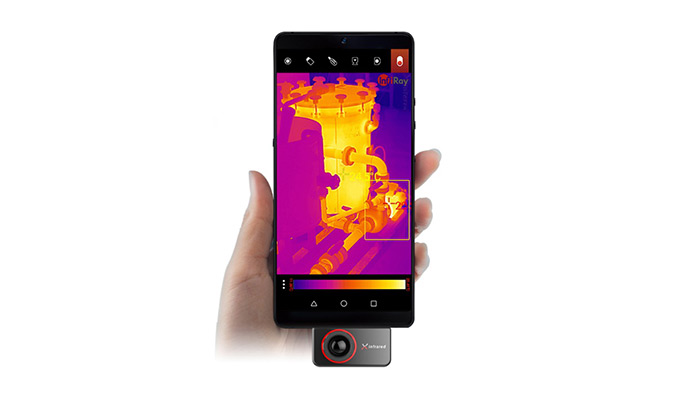Features and Functionalities of Smartphone Thermal Cameras

Smartphone thermal cameras represent a ground-breaking fusion of cutting-edge technology and everyday utility. As miniature marvels nestled within the confines of our smartphones, these thermal imaging sensors open up a world beyond the visible spectrum, offering insights into the thermal landscape of our surroundings. From detecting heat signatures in the dark of night to identifying energy inefficiencies in our homes, the features of smartphone thermal cameras are as diverse as they are impactful.
Here are features and functionalities typically associated with smartphone thermal cameras.
Thermal Imaging Capability: The primary feature, of course, is the ability to capture thermal images. Smartphone thermal camera utilizes infrared radiation to detect temperature variances, converting them into visible images. This capability allows users to visualize heat signatures emitted by objects and living beings.
Temperature Range: Smartphone thermal cameras typically offer a broad detection range, often from below-freezing temperatures to several hundred degrees Celsius. This wide range ensures versatility, making the camera useful in various scenarios, from checking for drafts in a home to assessing the temperature of mechanical equipment.
Resolution: The resolution of a thermal camera determines its ability to capture fine details in thermal images. Higher-resolution sensors provide clearer and more precise thermal data. Smartphone thermal cameras vary in resolution, with some offering resolutions comparable to standalone thermal imaging devices.
Color Palettes and Temperature Scales: Thermal cameras often have customizable color palettes and temperature scales. These features allow users to adjust the visualization of the thermal data according to their preferences and specific needs. Common color palettes include grayscale, rainbow, ironbow, and various color gradients, each offering a unique way to represent temperature differences.
Image and Video Capture: Like traditional smartphone cameras, thermal cameras integrated into smartphones typically offer image and video capture capabilities. Users can capture thermal images or record videos of thermal scenes, which can be useful for documentation, analysis, or sharing with others.
Real-time Temperature Measurement: Some smartphone thermal cameras offer real-time temperature measurement capabilities. This feature allows users to point the camera at an object or a person and instantly see the temperature reading on the screen. It can be particularly useful in building inspections, electrical troubleshooting, or medical diagnostics.
Integration with Smartphone Apps: Most smartphone thermal cameras have companion apps that enhance functionality. These apps may offer additional features such as data analysis tools, temperature alarms, or the ability to overlay thermal images with visible light images captured by the smartphone’s primary camera.
Portability and Convenience: One of the most significant advantages of smartphone thermal cameras is their portability and convenience. By integrating thermal imaging technology into smartphones, users can access thermal capabilities without needing additional bulky equipment. This portability makes thermal imaging more accessible in various industries and everyday applications.
Battery Life Considerations: Thermal cameras can consume additional battery power, especially when capturing high-resolution images or recording videos. Smartphone manufacturers and app developers often optimize the software to minimize battery drain while maximizing the camera’s performance. However, users should still be mindful of their device’s battery life when using the thermal camera extensively.
Cost and Accessibility: Smartphone thermal cameras offer a more affordable alternative to standalone thermal imaging devices. While professional-grade thermal cameras can be expensive, smartphone thermal cameras provide a cost-effective solution for hobbyists, DIY enthusiasts, homeowners, and professionals in various fields.
Why Smartphone Thermal Cameras Stand Out
Smartphone thermal cameras offer a range of benefits that can revolutionize how we interact with our environment and utilize technology in various fields:
Enhanced Safety and Security: Thermal cameras can detect heat signatures, making them invaluable tools for detecting potential hazards or security threats. For example, in fire fighting, they can help locate hotspots or individuals in smoke-filled environments where visibility is low. Law enforcement can aid in locating suspects or missing persons, even in darkness or dense foliage.
Building Inspections and Maintenance: Thermal imaging detects hidden structural issues, electrical faults, or water leaks within buildings. By identifying these problems early on, preventive maintenance can be conducted, reducing the risk of costly repairs or accidents. Homeowners, contractors, and building inspectors can benefit greatly from the ability to identify areas of energy loss or poor insulation, leading to increased energy efficiency and cost savings over time.
Outdoor Recreation and Wildlife Observation: Thermal cameras can enhance outdoor activities such as camping, hiking, and wildlife observation. They enable users to spot animals, even nocturnal ones, from a distance without disturbing them. Additionally, they can assist in search and rescue operations by helping locate lost individuals in challenging terrains or adverse weather conditions.
Health Monitoring and Medical Applications: Thermal imaging has promising applications in healthcare, including detecting changes in body temperature that may indicate illness or injury. Integrating thermal cameras into smartphones allows individuals to monitor their health more conveniently and regularly. Moreover, in the wake of global health crises, such as the COVID-19 pandemic, thermal imaging can aid in mass screenings for fevers and identify potential cases quickly.
Environmental Conservation and Agriculture: Thermal cameras can monitor environmental changes and help conservationists track wildlife populations, identify habitat hotspots, and detect illegal activities such as poaching. In agriculture, they can assess crop health, identify irrigation issues, and optimize resource allocation by providing insights into temperature variations across fields.
Educational and Research Purposes: Thermal imaging can be a valuable educational tool, allowing students to explore concepts related to heat transfer, thermodynamics, and environmental science hands-on. Researchers across various disciplines, from physics to biology, can leverage smartphone thermal cameras for field studies and data collection, expanding our understanding of natural phenomena.
DIY Projects and Hobbyist Applications: With the accessibility of smartphone thermal cameras, hobbyists and DIY enthusiasts can explore a wide range of projects, from building custom home automation systems to creating innovative gadgets. The ability to visualize thermal data in real time opens up creative possibilities for hobbyist inventors and makers.
Accessibility and Affordability: Integrating thermal imaging capabilities into smartphones makes this technology more accessible to a broader range of users. While standalone thermal cameras can be expensive and bulky, smartphone attachments or built-in features offer a more cost-effective and portable solution. This accessibility democratizes thermal imaging technology, empowering individuals across various industries and disciplines.
Final Thoughts
Smartphone thermal cameras offer a wide range of features and functionalities, making them versatile tools for various applications. From detecting energy inefficiencies in buildings to identifying heat sources in electronics or conducting search and rescue operations, these devices can revolutionize how we perceive and interact with thermal information in our surroundings.












